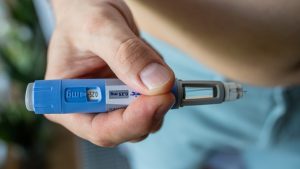Articles / 6 tips for managing anaphylaxis

Allergy specialist Dr Celia Zubrinich offers practical tips for managing anaphylaxis – and some traps to avoid as well…
Two adrenaline auto-injectors are available in Australia: the EpiPen® has been used for decades, and the Anapen® came onto the market in late 2021. Both devices come in doses of 0.15 mg for children and 0.3 mg for anyone who weighs 20kg or more. The Anapen® also comes in a 0.5 mg dose that is safe for all individuals over 50 kg, in alignment with ASCIA guidelines, Dr Zubrinich says. For context, this is the dose that people would receive by ambulance and hospital ED protocols, as well as by weight-based dosing guidelines from ASCIA if you’re not using an auto-injector.
Studies have shown some people need more than one 0.3 mg dose of intramuscular adrenaline to treat anaphylaxis effectively and the 0.5 mg dose may therefore be more suitable in some cases, particularly “where we know that people have needed a lot of adrenaline resuscitation in the past – and really [for] anyone over 50 kg,” Dr Zubrinich notes.
Physiologic data shows that 0.5 mg causes a greater peak in adrenaline levels compared to 0.3mg, but there are no prospective data to say this dose is mandatory or definitely superior, so patient habit or preference for a certain device should also be taken into consideration.
“When anaphylaxis is occurring it is very frightening and people often cannot think very flexibly, so if people have been trained and hardwired how to use a certain device it may be quite appropriate for them to stick with that,” Dr Zubrinich says.
“If they are very open to change or if they are newly receiving an adrenaline pen, then both options should be carefully considered.”
The devices have other differences that may influence the choice, she adds.
The EpiPen® is slightly shorter but a little thicker than the Anapen and the mode of administration differs. You need to remove both ends of the Anapen, place it on the thigh, and press the red button to activate adrenaline delivery. With the EpiPen, you need to remove one end and press it into the thigh, which activates delivery via a spring-loaded mechanism.
“It can be worth demonstrating this to patients so they can select which one seems more intuitive to them,” Dr Zubrinich says.
Delayed adrenaline administration has repeatedly been shown to result in more severe or fatal anaphylaxis outcomes, so GPs should instruct patients to use their auto-injector if they have any systemic life-threatening features, including “anything to do with the airway or cardiovascular compromise where we think blood pressure is low,” Dr Zubrinich says.
She notes measuring blood pressure may not be an option at the time, but “if the person has that distinctive sensation of the blood pressure dropping – faintness, weakness, dizziness, that primal sense of ‘I need to lie down’ – then adrenaline should be administered.”
Importantly, encourage patients to use their auto-injector if in doubt.
“If they are sort of feeling like ‘oh, I don’t think I should do it … I think maybe I am on the line”, err on the side of caution,” she says. “If it was to be administered, I reassure people nothing bad has been done. You cannot essentially harm yourself with a dose of intramuscular adrenaline.”
PBS authority permits people to carry two devices. Dr Zubrinich advises patients to always have both with them so they are not worried about using their auto-injector “too early and wasting it.” For school-age children, most schools require that an auto-injector is kept at the school, meaning only one will be available at home, but the ‘school device’ can be requested during holidays or when travelling.
Patients should know they need to call an ambulance if they’ve used their auto-injector and to explain this when they ring, she adds.
“I emphasise to people when they call for emergency services not to say ‘oh, I’m not sure what was in my taco wrap’ or ‘I don’t know why I reacted’… If you say, ‘I have used my adrenaline pen’ then they know this is anaphylaxis and it is a top priority.”
While the initial authority must come from a specialist such as an allergist, immunologist, respiratory physician or paediatrician, if someone has received adrenaline in hospital, then then any doctor can prescribe an auto-injector on an authority prescription through the PBS, she says.
“So if your patient gets sent home from ED, got adrenaline, but did not get an adrenaline pen script and you are in the process of making a referral to an allergist, you can provide them with an authorised EpiPen or Anapen prescription in the meantime.”
If an initial authority prescription for an auto-injector has been issued, any doctor can ring up or apply online through PRODA and get authority for two more auto-injectors if a device is used, lost, broken, or out of date and they have PBS authorisation.
Additionally, while only two auto-injectors can be prescribed on any PBS-authorised script, more than one script can be dispensed to a patient on a separate occasion if it is deemed clinically appropriate or necessary.
“There might be circumstances where you think it is appropriate to have more than two pens, for example people going to very remote locations, some children who live between two households, people who’ve had very severe anaphylaxis … and we know they’ve needed a lot of adrenaline resuscitation in the past,” she says.
Some paediatric food allergies may resolve spontaneously, so children should be reviewed carefully to relieve any unnecessary burden of allergen avoidance, Dr Zubrinich says.
“That can be done usually every couple of years,” she says. “And it can be informed by what has happened in real life as well.”
Some young people have a lot of reactions, she notes, “and we generally like to see them quite regularly.” Others with established allergens, a good management plan, and a track record of fewer reactions may not need to be seen as frequently.
When children are approaching adulthood, she advises arranging an assessment either with their paediatrician or an adult allergist to transition the responsibility for managing them.
A new adult-onset food allergy or a food allergy that has continued from childhood into adulthood is generally here to stay, she adds.
“Thereafter we do not see them in adulthood routinely unless something changes – they want to get pregnant or they want to travel or have a refresher or they say, ‘you know what, I ate this and nothing happened’.”
She stresses that allergy specialists do more than prescribe adrenaline pens. “We spend a lot of time in allergy clinics un-diagnosing suspected allergens rather than just diagnosing things, so I think that’s really important for individual safety but also their quality of life – especially when we think this is going to be a long-term avoidance approach.”
Importantly, many practices triage referrals, so let them know if your patient has been newly diagnosed and the allergen is unknown or if you been unable to get an adrenaline pen. “Those individuals are certainly prioritised,” Dr Zubrinich says.
This is “absolutely critical,” Dr Zubrinich says, explaining that studies of fatal anaphylaxis describe incidents where people “have been propped up, told to walk out to the car or tried to get in the shower, lost consciousness, and never regained it.”
An exception to this is in late pregnancy, when women should lie on their left side rather than supine to reduce the risk of inferior vena cava compression.
People who are extremely breathless and find it terrifying or very uncomfortable to lie down may sit with legs extended (not on a chair with legs hanging) and importantly, should be instructed not to walk around, she adds.
It should be emphasised that an upright position, standing suddenly, or walking are associated with a greater risk of a fatal reaction.
They can then be monitored in case of protracted or rebound symptoms.
Follow these steps if a patient in your clinic experiences anaphylaxis.
Other therapies that can support recovery include:
However, “none of those things should ever be prioritised to the detriment of adrenaline.”
Intramuscular adrenaline can be administered to anyone “without restriction or hesitation,” Dr Zubrinich adds.
Unlike intravenous adrenaline – which is associated with significant toxicity and should only be administered in a highly monitored setting – there are no absolute contraindications to intramuscular adrenaline at normal doses. It is suitable for people with known ischaemic heart disease, lung disease, and women who are pregnant.
Key messages:
Useful resources:
ASCIA’s anaphylaxis action plan was updated last year in line with the best available evidence.
ASCIA also has an Anaphylaxis Travel Plan and checklist for travellers.
Learn more about managing anaphylaxis or listen to the podcast with Dr Zubrinich.
Allergy & Anaphylaxis Australia provides free information and support for patients. Trained health professionals answer calls and respond to queries about everyday management. Visit allergyfacts.org.au to subscribe. Ph 1300 728 000
Editor’s note: This is an updated version of an article first published on 13 April 2024. It has been revised to include clarifications and feedback from Dr Katie Frith, Paediatric Immunologist and Allergist at Sydney Children’s Hospital in Randwick.
Acknowledgements: This article has been reviewed by Dr Katie Frith, Paediatric Immunologist and Allergist at Sydney Children’s Hospital in Randwick, Maria Said, CEO of Allergy & Anaphylaxis Australia and Allergy Specialist Dr Celia Zubrinich.

Menopausal Hormone Therapy - What Dose of Estrogen is Best?

Cardiovascular Benefits of GLP1s – New Evidence

Oral Contraceptive Pill in Teens

RSV and the Heart



Modified but kept in place
Eliminated entirely without replacement
Maintained as is
Completely replaced with an alternative system
Listen to expert interviews.
Click to open in a new tab
Browse the latest articles from Healthed.
Once you confirm you’ve read this article you can complete a Patient Case Review to earn 0.5 hours CPD in the Reviewing Performance (RP) category.
Select ‘Confirm & learn‘ when you have read this article in its entirety and you will be taken to begin your Patient Case Review.
Menopause and MHT
Multiple sclerosis vs antibody disease
Using SGLT2 to reduce cardiovascular death in T2D
Peripheral arterial disease
